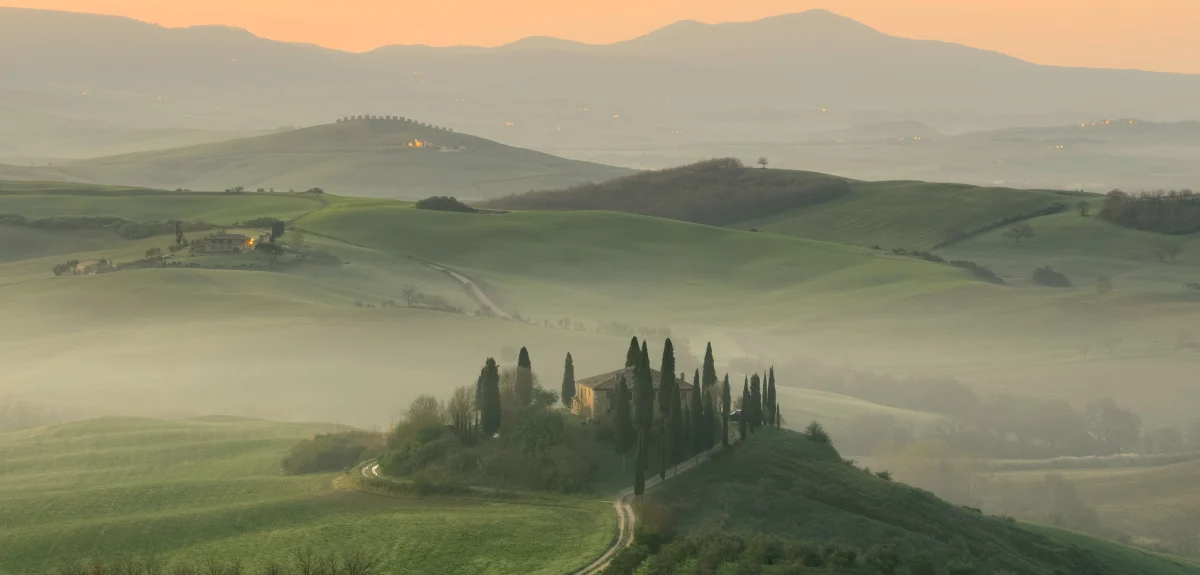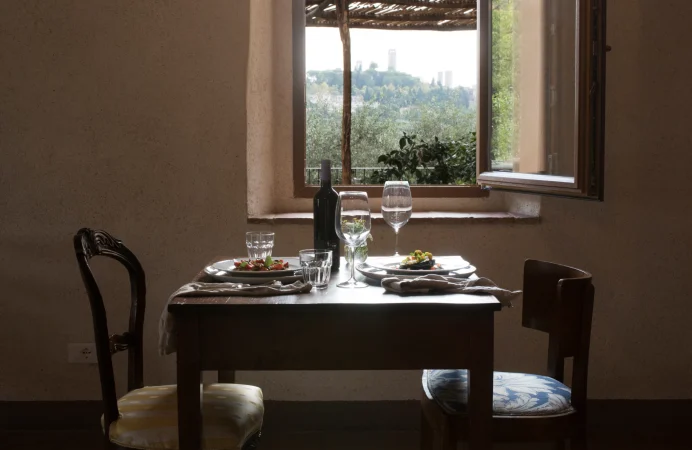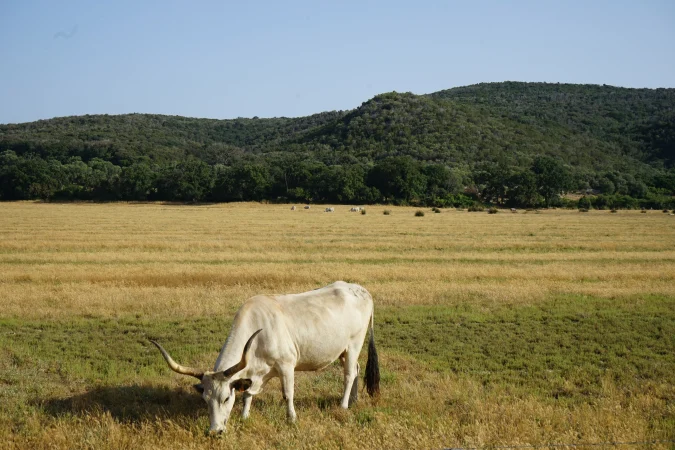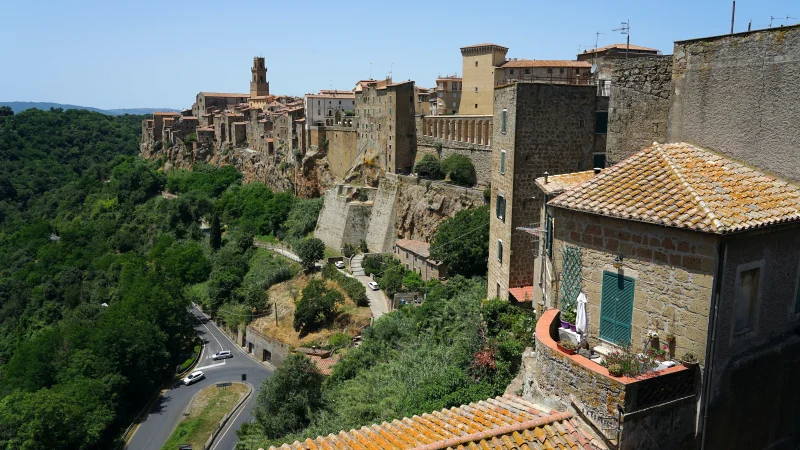
Green travel tips for Tuscany
Off the grid wines and green stars.
A vineyard where geese roam free
Casa Emma

Hand-picked grapes and biodynamic farming that respects the phases of the moon—Casa Emma is a vineyard with a strong focus on nature and the environment. They even collect the grape skins, drying and grinding them into a flour that you can buy here. The farm is powered by solar energy, and with a flock of geese walking around eating weeds and insects, they have managed to reduce the use of tractors and machinery by 80%. The wines are Chianti or Supertuscans, which do not follow the classic rules and blend in grape varieties other than Sangiovese.

Eco-friendly accommodation by the beach
Paradù Ecovillage & Resort

The whole family will enjoy this eco-resort on the Etruscan coast in Tuscany. Here you can stay in small cottages or indulge in more luxurious glamping. Take a dip in the sea or in one of the resort’s pools, and for those who want to engage in more sporting activities, everything from archery and padel to beach volleyball is on offer. The Etruscan coast is also perfect for cycling excursions and at the end of the day you can enjoy local specialties under the setting sun.

Vegan oasis in San Gimignano
Agrivilla I Pini

The I Pini restaurant is part of an “agrivilla” (estate) of the same name, meaning you can stay overnight if you wish. The food at I Pini is entirely vegan and always organic and the dishes are “from seed to table,” meaning that as much as possible of what is served comes from the farm’s own garden. You can have breakfast, lunch and dinner while enjoying stunning views of rolling hills. Just remember that it’s important to book a table in advance (and let them know if you’re gluten intolerant).
Green Michelin star in San Felice
Il Poggio Rosso

Housed in the luxurious Borgo San Felice Resort is the Il Poggio Rosso restaurant, run by Colombian chef Juan Quintero. The menu features an exciting blend of local, Tuscan ingredients and a more South American temperament and seasoning. Just take dishes like steamed snapper with tobacco, eel and coconut or purple shrimp from Porto Santo Stefano with golden berries, tomatoes and coffee. Il Poggio Rosso not only has a regular Michelin star, but also a coveted green star that is only awarded to restaurants at the forefront of sustainability.
Viticulture off the grid
Salcheto

The Salcheto vineyard in Montepulciano sits on a hill with wonderful views of the Tuscan countryside. The vineyard is completely “off the grid,” meaning that it is independent of the Italian electricity network. It’s the first vineyard in the country to achieve this, using solar, geothermal and other renewable sources of energy—for example, the underground lighting comes from sunlight passing through small reflective pathways. It’s no surprise that the winery was named Green Winery of the Year back in 2014. The wines themselves are often biodynamic and sulfate-free, while Salcheto uses local mushrooms during the fermentation process. A special wine series has also been created with French filmmaker Michel Gondry. As you can see, Salcheto is a must for anyone interested in sustainable viticulture.
Cycling among the hills of Tuscany
Anima Toscana Bike Tours

A perfect way to get around and experience Tuscany is by bike. There’s nothing wrong with renting bikes or e-bikes for an hour or two, but a longer cycling trip offers so much more. Anima Toscana organizes both day trips and week-long tours where, in addition to breathtaking landscapes, you can sample the region’s wines and learn how to cook Tuscan food. They can also put together tailor-made cycling tours for you and your traveling companions.
Luxury accommodation in harmony with nature
Borgo Pignano

For those who want to live in harmony with nature but without compromising on quality, Borgo Pignano is the perfect option. The farm has been completely renovated using sustainable materials such as local stone and organic paint, the water for the gardens and crops comes from filtered rainwater, and the buildings are heated by solar energy or wood from the farm’s own forests. Here you can go horse rising or take part in yoga and art classes—all in a lovely, calming environment. The food offerings on the farm range from Villa Pignano (also with a green star) to an outdoor restaurant open during the summer season.

Coastal walking
Parco Regionale della Maremma

This 45,000-acre regional park can be hiked, cycled, ridden on horseback and even crossed by canoe. Pine forests, low mountains, beaches and the wetlands of the Ombrone River ensure a varied landscape for visitors, and the numerous caves, archaeological sites and medieval towers once used by pirates are available for the adventurous. Please note that during the summer, due to fire risk, large parts of the park are off limits unless you book a guided tour.

A Green Pioneer in 2024
Grosseto

The town of Grosseto in the Maremma has been awarded the status of Green Pioneer of Smart Tourism by the European Commission for 2024. From here you can cycle into the Parco Regionale della Maremma and the town has made mobility a priority. Accessibility is also important—everyone should be able to get to the beach or out into nature. Add to all of this a city with an exciting history and cultural heritage, and you can see why it is considered an ideal family destination with its peaceful atmosphere, many activities and proximity to both the sea and the mountains.
EuroBonus Conscious Traveler
What is the EuroBonus Conscious Traveler?
It’s a reward program for those who make sustainable choices and in doing so show their support for SAS’ journey towards sustainable flying, to be launched in early 2024.
How does it work?
Anyone registered for EuroBonus can become a Conscious Traveler, but there are ten steps to be taken before you get the award. Some examples of steps to complete are learning more about biofuels, donating EuroBonus Points to charity or traveling on a biofuel ticket.
Read more about the EuroBonus Conscious Traveler here.
Text by Daniel Björk